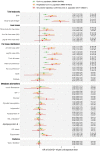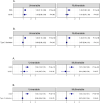Associations between body composition, fat distribution and metabolic consequences of excess adiposity with severe COVID-19 outcomes: observational study and Mendelian randomisation analysis
- PMID: 35031696
- PMCID: PMC8758930
- DOI: 10.1038/s41366-021-01054-3
Associations between body composition, fat distribution and metabolic consequences of excess adiposity with severe COVID-19 outcomes: observational study and Mendelian randomisation analysis
Abstract
Background: Higher body mass index (BMI) and metabolic consequences of excess weight are associated with increased risk of severe COVID-19, though their mediating pathway is unclear.
Methods: A prospective cohort study included 435,504 UK Biobank participants. A two-sample Mendelian randomisation (MR) study used the COVID-19 Host Genetics Initiative in 1.6 million participants. We examined associations of total adiposity, body composition, fat distribution and metabolic consequences of excess weight, particularly type 2 diabetes, with incidence and severity of COVID-19, assessed by test positivity, hospital admission, intensive care unit (ICU) admission and death.
Results: BMI and body fat were associated with COVID-19 in the observational and MR analyses but muscle mass was not. The observational study suggested the association with central fat distribution was stronger than for BMI, but there was little evidence from the MR analyses than this was causal. There was evidence that strong associations of metabolic consequences with COVID-19 outcomes in observational but not MR analyses. Type 2 diabetes was strongly associated with COVID-19 in observational but not MR analyses. In adjusted models, the observational analysis showed that the association of BMI with COVID-19 diminished, while central fat distribution and metabolic consequences of excess weight remained strongly associated. In contrast, MR showed the reverse, with only BMI retaining a direct effect on COVID-19.
Conclusions: Excess total adiposity is probably casually associated with severe COVID-19. Mendelian randomisation data do not support causality for the observed associations of central fat distribution or metabolic consequences of excess adiposity with COVID-19.
© 2022. The Author(s).
Conflict of interest statement
PA and SAJ are investigators on a trial of total diet replacement funded by Cambridge Weight Plan. PA spoke at a symposium at the Royal College of General Practitioners conference funded by Novo Nordisk. Both these activities resulted in payments to the University of Oxford but not to the investigators.
Figures


Comment in
-
Warum Adipöse so Covid-anfällig sind.MMW Fortschr Med. 2022 Nov;164(19):28-29. doi: 10.1007/s15006-022-2053-y. MMW Fortschr Med. 2022. PMID: 36310267 Free PMC article. Review. German. No abstract available.
References
-
- England PH. Excess weight and COVID 19: insights from new evidence. Public Health England: London, 2020.
-
- Gao M, Piernas C, Astbury NM, Hippisley-Cox J, O’Rahilly S, Aveyard P, et al. Associations between body-mass index and COVID-19 severity in 6· 9 million people in England: a prospective, community-based, cohort study. Lancet Diabetes Endocrinol. 2021;9:350–9. doi: 10.1016/S2213-8587(21)00089-9. - DOI - PMC - PubMed
-
- Palaiodimos L, Kokkinidis DG, Li W, Karamanis D, Ognibene J, Arora S, et al. Severe obesity, increasing age and male sex are independently associated with worse in-hospital outcomes, and higher in-hospital mortality, in a cohort of patients with COVID-19 in the Bronx, New York. Metabolism. 2020;108:154262. doi: 10.1016/j.metabol.2020.154262. - DOI - PMC - PubMed
Publication types
MeSH terms
Grants and funding
LinkOut - more resources
Full Text Sources
Medical

